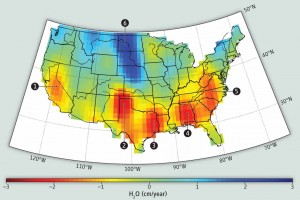
Data from the German-NASA GRACE satellites highlights groundwater depletion hotspots in the United States. CREDIT: CAROLINE DE LINAGE/UNIV. OF CALIFORNIA, IRVINE, Science magazine
Jay Famiglietti, from UC Irvine in California, and his colleagues have made something of a scientific cottage industry out of the use of data from the German-NASA GRACE satellites (short for Gravity Recovery and Climate Experiment) to measure changes in groundwater around the world. Not surprisingly, it’s going down as humans pump it out to use faster than the globe’s hydrologic system can put it back. The GRACE numbers have substantially improved our understanding of this problem (see, for example, India, California’s Central Valley, the Tigris-Euphrates basins). “GRACE may be the only hope for groundwater depletion assessments in data-poor regions of the world,” they wrote in 2007.
But there are problems, as Famiglietti and Matthew Rodell write in this week’s Science (link might be behind Science’s paywall). GRACE was launched in 2002 with a five-year nominal lifetime, which it has obviously exceeded. A follow-on is not planned to launch until 2017:
For GRACE and its successors to maximize their value for water management, key issues must be addressed. First, the current 2- to 6-month latency before GRACE data are released must be substantially reduced to enable their use in seasonal prediction. Second, GRACE data should be better integrated into the modeling and decision support systems used by operational water management centers. Finally, next-generation missions beyond GRACE-FO should aim to achieve higher spatial (<50,000 km2) and temporal (weekly or biweekly) resolution, for example through novel orbital configurations, so that smaller river basins and aquifers can be observed directly. The availability of GRACE data at these finer scales, at which most planning decisions are made, would likely ensure their broader use in water management.
NASA’s Fiscal Year 2014 budget (big pdf) $83.4 million for work on the GRACE follow-on mission. Preliminary estimate puts the total life cycle cost at $404m to $460m. I don’t follow NASA closely, or understand its budget dynamics, so I’ve no idea if that’s a reasonable number, or what the tradeoffs are in terms of other programs struggling for funding in the Commerce, Justice, Science and Related Agencies appropriations bills in which NASA has to compete.

Pingback: Science news and reports: Tidal marsh restoration, subsided islands, GRACE satellite imagery, adaptive management, declining snowpacks and more! » MAVEN'S NOTEBOOK | MAVEN'S NOTEBOOK